Integrated and Portable Probe Based on Functional Plastic Scintillator for Detection of Radioactive Cesium
Abstract
:1. Introduction
2. Materials and Methods
2.1. Chemicals
2.2. Fabrication of a Functional Plastic Scintillator
2.3. MCNP Simulation
2.4. Manufacturing of Integrated Functional Plastic Detection System
3. Results and Discussion
4. Conclusions
Supplementary Materials
Author Contributions
Funding
Institutional Review Board Statement
Informed Consent Statement
Data Availability Statement
Acknowledgments
Conflicts of Interest
References
- Seo, B.K.; Kwon, S.W.; Nam, J.S.; Roh, C.H.; Moon, J.K.; Ahn, B.G.; Yang, H.M.; Lee, G.W.; Lee, I.H.; Jeong, K.H.; et al. Development of Decommissioning, Decontamination and Remediation Technology for Nuclear Facilities; No. KAERI/RR-3939/2015; Korea Atomic Energy Research Institute: Daejeon, Korea, 2015. [Google Scholar]
- Yukiyasu, N.; Mami, Y.; Yukihisa, S.; Tatsuo, T. Distribution of the 134Cs/137Cs ratio around the Fukushima Daiichi nuclear power plant using an unmanned helicopter radiation monitoring system. J. Nucl. Sci. Technol. 2016, 53, 468–474. [Google Scholar]
- Masamichi, C.; Hiroaki, T.; Haruyasu, N.; Genki, K.; Satoshi, M.; Tatsuo, T.; Kimiaki, S.; Yukiyasu, N. Utilization of 134Cs/137Cs in the environment to identify the reactor units that caused atmospheric releases during the Fukushima Daiichi accident. Sci. Rep. 2016, 6, 31376. [Google Scholar]
- Chino, M.; Nakayama, H.; Nagai, H.; Terada, H. Preliminary estimation of release amounts of 131I and 137Cs accidentally discharged from the Fukushima Daiichi nuclear power plant into atmosphere. J. Nucl. Sci. Technol. 2011, 48, 1129–1134. [Google Scholar] [CrossRef]
- Kobayashi, T.; Nagai, H.; Chino, M.; Kawamura, H. Source term estimation of atmospheric release due to the Fukushima Dai-ichi Nuclear Power Plant accident by atmospheric and oceanic dispersion simulations. J. Nucl. Sci. Technol. 2013, 50, 255–264. [Google Scholar] [CrossRef] [Green Version]
- Wai, K.M.; Krstic, D.; Nikezic, D.; Lin, T.H.; Yu, P.K.N. External Cesium-137 doses to humans from soil influenced by the Fukushima and Chernobyl nuclear power plants accidents: A comparative study. Sci. Rep. 2020, 10, 7902. [Google Scholar] [CrossRef] [PubMed]
- Pollanen, R.; Toivonen, H.; Valkama, I. Transport of radioactive particles from the Chernobyl accident. Atmos. Environ. 1997, 31, 3575–3590. [Google Scholar] [CrossRef]
- Puhakka, T.; Jylha, K.; Saarikivi, P.; Koistinen, J.; Koivukoski, J. Meteorological factors influencing the radioactive deposition in Finland after the Chernobyl accident. J. Appl. Meteorol. Climatol. 1990, 29, 813–829. [Google Scholar] [CrossRef] [Green Version]
- Krstić, D.; Nikezic, D.; Stevanovic, N.; Jelic, M. Vertical profile of 137Cs in soil. Appl. Radiat. Isot. 2004, 61, 1487–1492. [Google Scholar] [CrossRef]
- Taira, Y.; Hayashida, N.; Tsuchiya, R.; Yamafuchi, H.; Takahashi, J.; Kazlovsky, A.; Urazalin, M.; Rakhypbekov, T.; Yamashita, S.; Takamura, N. Vertical distribution and estimated doses from artifcial radionuclides in soil samples around the Chernobyl Nuclear Power Plant and the Semipalatinsk Nuclear Testing Site. PLoS ONE 2013, 8, e57524. [Google Scholar] [CrossRef]
- Ostlund, K.; Samuelsson, C.; Mattsson, S.; Raaf, C.L. The infuence of 134Cs on the 137Cs gamma-spectrometric peak-to-valley ratio and improvement of the peak-to-valley method by limiting the detector feld of view. Appl. Radiat. Isot. 2017, 128, 249–255. [Google Scholar] [CrossRef]
- Yasunari, T.J.; Stohl, A.; Hayano, R.S.; Burkhart, J.F.; Eckhardt, S.; Yasunari, T. Cesium-137 deposition and contamination of Japanese soils due to the Fukushima nuclear accident. Proc. Natl. Acad. Sci. USA 2011, 108, 19530–19534. [Google Scholar] [CrossRef] [Green Version]
- Guntay, S.; Powers, D.A.; Devell, L. The Chernobyl Reactor Accident Source Term: Development of a Consensus View; NEA/CSNI/R-1995-24; Nuclear Energy Agency of the OECD(NEA): Issy-les-Moulineaux, France, 1996. [Google Scholar]
- Claußen, A.; Rosen, A. 30 Years Living with Chernobyl, 5 Years Living with Fukushima. Health Effects of the Nuclear Disasters in Fukushima and Chernobyl; Beavis, M., Thomasson, C., Hiranuma, Y., Eds.; IPPNW Germany: Berlin, Germany, 2016; p. 17. [Google Scholar]
- Radionuclide Half-Life Measurements Data. Available online: https://www.nist.gov/pml/radionuclide-half-life-measurements/radionuclide-half-life-measurements-data (accessed on 1 June 2021).
- Bikit, I.; Mrdja, D.; Veskovic, M.; Krmar, M.; Slivka, J.; Todorovic, N.; Bikit, K. Coincidence techniques in gamma-ray spectroscopy. J. Phys. Proc. 2012, 31, 84–92. [Google Scholar] [CrossRef] [Green Version]
- Yunoki, A.; Kawada, Y.; Yamada, T.; Unno, Y.; Sato, Y.; Hino, Y. Absorption and backscatter of internal conversion electrons in the measurements of surface contamination of Cs-137. J. Appl. Radiat. Isot. 2013, 81, 261–267. [Google Scholar] [CrossRef] [PubMed]
- Yoshizawa, Y. Beta and gamma ray spectroscopy of Cs-137. J. Nucl. Phys. 1958, 5, 122–140. [Google Scholar] [CrossRef]
- Hsue, S.T.; Langer, L.M.; Tang, S.M. Precise determination of the shape of the twice forbidden beta spectrum of Cs-137. J. Nucl. Phys. 1966, 86, 47–55. [Google Scholar] [CrossRef]
- Lavelle, K.B.; Essex, R.M.; Carney, K.P.; Cessna, J.T.; Hexel, C.R. A reference material for evaluation of 137 Cs radiochronometric measurements. J. Radioanal. Nucl. Chem. 2018, 318, 195–208. [Google Scholar] [CrossRef]
- Cummings, D.G.; Sommers, J.D.; Adamic, M.L.; Jimenez, M.; Giglio, J.J.; Carney, K.P.; Grimm, K. Characterization of sealed radioactive sources: Uncertainty analysis to improve detection methods. J. Radioanal. Nucl. Chem. 2009, 282, 923–928. [Google Scholar] [CrossRef]
- Merritt, J.S.; Taylor, J.G.V. Decay of Cesium137 Determined by Absolute Counting Methods. J. Anal. Chem. 1965, 37, 351–354. [Google Scholar] [CrossRef]
- Behrens, H.; Christmas, P. The beta decay of 137Cs. J. Nucl. Phys. A 1983, 399, 131–140. [Google Scholar] [CrossRef]
- Goodier, I.W.; Makepeace, J.L.; Stuart, L.E.H. The decay scheme of cesium 137. J. Appl. Radiat. Isot. 1975, 26, 490–492. [Google Scholar] [CrossRef]
- Kulkarni, S.S.; Khadke, U.V. Low Energy Gamma Radiation Induced Effects on Ultrasonic Velocity and Acoustic Parameters in Polyvinylidene Fluoride Solution. J. Mat. 2016, 2016, 8470689. [Google Scholar] [CrossRef] [Green Version]
- Gandini, M.; Villa, I.; Beretta, M.; Gotti, C.; Imran, M.; Carulli, F.; Fantuzzi, M.S.; Zaffalon, M.; Brofferio, C.; Manna, L.; et al. Efficient, fast and reabsorbtion free perovskite nanocrystal based sensitized plastic scintillators. Nat. Nanotechnol. 2020, 15, 462–468. [Google Scholar] [CrossRef]
- Hajagos, T.J.; Liu, C.; Cherepy, N.J.; Pei, Q. High-Z Sensitized plastic scintillators: A review. Adv. Mater. 2018, 30, 1706956. [Google Scholar] [CrossRef] [PubMed]
- Yoon, S.C.; Chang, S.Y.; Lee, T.Y.; Kim, B.H.; Jeong, D.Y.; Lee, S.Y.; Lee, K.C.; Lee, H.S.; Ha, C.W. A State of the Art on the Compton Suppression Technology for Background Reduction of the Gamma Spectrometry; No. KAERI/AR-1199/2018; Korea Atomic Energy Research Institute: Daejeon, Korea, 2018. [Google Scholar]
- Letant, S.E.; Wang, T.F. Study of porous glass doped with quantum dots or laser dyes under alpha irradiation. Appl. Phys. 2006, 88, 103110. [Google Scholar] [CrossRef]
- Dai, Q.; Li, D.; Chen, H.; Kan, S.; Li, H.; Gao, S.; Hou, Y.; Liu, B.; Zou, G. Colloidal CdSe nanocrystals synthesized in noncoordinating solvents with the addition of a secondary ligand: Exceptional growth kinetics. J. Phys. Chem. B 2006, 110, 16508–16513. [Google Scholar] [CrossRef]
- Shafqat, U.L. Development of Element Loaded Plastic Scintillators. Master’s Thesis, Department of Physics, Kyungpook National University, Daegu, Korea, July 2007. [Google Scholar]
- Liu, C.; Hajagos, T.J.; Kishpaugh, D.; Jin, Y.; Hu, W.; Chem, Q.; Pei, Q. Facile Single-Precursor Synthesis and Surface Modification of Hafnium Oxide Nanoparticles for Nanocomposite γ-Ray Scintillators. Adv. Funct. Mater. 2015, 25, 4607–4616. [Google Scholar] [CrossRef]
- Nam, J.S.; Kim, Y.E.; Hong, S.B.; Seo, B.K.; Kim, K.H. Performance Evaluation of a Plastic Scintillator for Making a In-situ Beta Detector. J. New Phys. Sae Mulli 2017, 67, 1080–1085. [Google Scholar] [CrossRef]
- Sahi, S.; Magill, S.; Ma, L.; Xie, J.; Chen, W.; Jones, B.; Nygren, D. Wavelength-shifting properties of luminescence nanoparticles for high energy particle detection and specific physics process observation. Sci. Rep. 2018, 8, 10515. [Google Scholar] [CrossRef]
- Oktyabrsky, S.; Yakimov, M.; Tokranov, V.; Murat, P. Integrated semiconductor quantum dot scintillation detector: Ultimate Limit for speed and light yield. IEEE Trans. Nucl. Sci. 2016, 63, 656–663. [Google Scholar] [CrossRef]
- Nam, J.S.; Hong, S.B.; Seo, B.K.; Kim, Y.E. Characteristics of Beta-ray measurements of plastic scintillators containing Gd2O3 or CdTe. J. New Phys. Sae Mulli 2019, 69, 625–630. [Google Scholar] [CrossRef]
- Yalcin, S.; Gurler, O.; Gundogdu, O.; Kaynak, G. Monte Carlo simulation of gamma-ray total counting efficiency for a phoswich detector. Radiat. Meas. 2009, 44, 80–85. [Google Scholar] [CrossRef]
- Han, B.S.; Shim, H.J.; Kim, C.H. Development and Valification of MCCARD Gamma-ray transport routine. In Proceedings of the Korean Nuclear Society Conference, Kyungju, Korea, 27–28 May 2004. [Google Scholar]
- Park, J.W.; Yang, J.S.; Kim, H.J. A Study on Radiation Safety Measures for the Use of High-Energy Beta-Ray Sources in Medical Fields; No. KINS-HR-332; Korea Institute of Nuclear Safety: Daejeon, Korea, 2000. [Google Scholar]
- Kim, G.H.; Park, J.W. Modeling of the plastic detector for measuring the in pipe beta-ray contamination using Monte Carlo simulation methods. In Proceedings of the Korean Radioactive Waste Society Conference, Jeju, Korea, 10–12 November 2004. [Google Scholar]
- Zho, H.; Yu, H.; Redding, C.; Li, Z.; Chen, T.; Meng, Y.; Hajagos, T.J.; Hayward, J.P.; Pei, Q. Scintillation Liquids loaded with Hafnium Oxide Nanoparticles for spectral resolution of gamma rays. ACS Appl. Nano Mater. 2021, 4, 1220–1227. [Google Scholar] [CrossRef]
- ET Enterprises. Available online: https://et-enterprises.com/products/photomultipliers/product/p9266b-series (accessed on 9 May 2021).
- Chen, W.; Zhang, J.; Westcott, S.L. The origin of X-Ray luminescence from CdTe nanoparticles in CdTe/BaFBr:Eu2+ nanocomposite phosphors. J. Appl. Phys. 2006, 99, 34302. [Google Scholar] [CrossRef]
- Kang, Z.; Zhang, Y.; Menkara, H.; Wagner, B.K.; Summers, C.J.; Lawrence, W.; Nagarkar, V. CdTe quantum dots and polymer nanocomposites for X-Ray scintillation and imaging. J. Appl. Phys. 2011, 98, 181914. [Google Scholar] [CrossRef] [PubMed] [Green Version]
- Hossu, M.; Liu, Z.; Yao, M.; Ma, L.; Chen, W. X-ray luminescence of CdTe quantum dots in LaF3:Cd/CdTe nanocomposites. J. Appl. Phys. 2012, 100, 13109. [Google Scholar]
- Dhere, R.G.; Duenow, J.N.; Dehart, C.M.; Li, J.V.; Kuciauskas, D.; Gessert, T.A. Development of Substrate Structure CdTe Photovoltaic Devices with Performance Exceeding 10%. In Proceedings of the 2012 IEEE Photovoltaic Specialists Conference, Austin, TX, USA, 3–8 June 2012. [Google Scholar]
- Shen, M.; Jia, W.; You, Y.; Hu, Y.; Li, F.; Tian, S.; Li, J.; Jin, Y.; Han, D. Luminescent properties of CdTe quantum dots synthesized using 3-mercaptopropionic acid reduction of tellurium dioxide directly. Nanoscale Res. Lett. 2013, 8, 253. [Google Scholar] [CrossRef] [Green Version]
- Li, H.; Lu, W.; Zhao, G.; Song, B.; Zhou, J.; Dong, W.; Han, G. Silver ion-doped CdTe quantum dots as fluorescent probe for Hg2+ detection. RSC Adv. 2020, 10, 38965–38973. [Google Scholar] [CrossRef]
- Zhang, J.; Wei, Y.; Qiu, S.; Xiong, Y. A highly selective and simple fluorescent probe for salbutamol detection based on thioglycolic acid-capped CdTe quantum dots. Spectrochim. Acta Part A Mol. Biomol. Spectrosc. 2021, 247, 119107. [Google Scholar] [CrossRef]
- Flores-Pacheco, A.; Sanchez-Zeferino, R.; Saaveddra-Rodriguez, G. Enhanced Stokes-shift and dispersibility in non-polar PMMA solvent of CdTe quantum dots by silica coating. Chem. Phys. 2021, 544, 111102. [Google Scholar] [CrossRef]
- Da Rosa, L.T.A.; Aversa, I.F.S.; Raphael, E.; Polo, A.S.; Duarte, A.; Schiavon, M.A.; Virtuoso, L.S. Improving Photoluminescence Quantum Yield of CdTe Quantum Dots Using a Binary Solvent (Water + Glycerin) in the One-Pot Approach Synthesis. J. Braz. Chem. Soc. 2021, 32, 860–868. [Google Scholar]
- Goryunova, M.A.; Tsipotan, A.S.; Slabko, V.V. Photostability of CdTe Quantum Dots and Graphene Quantum Dots under their Continuous Visible and UV Irradiation. J. Sib. Fed. Univ. Math. Phys. 2021, 14, 249–257. [Google Scholar]
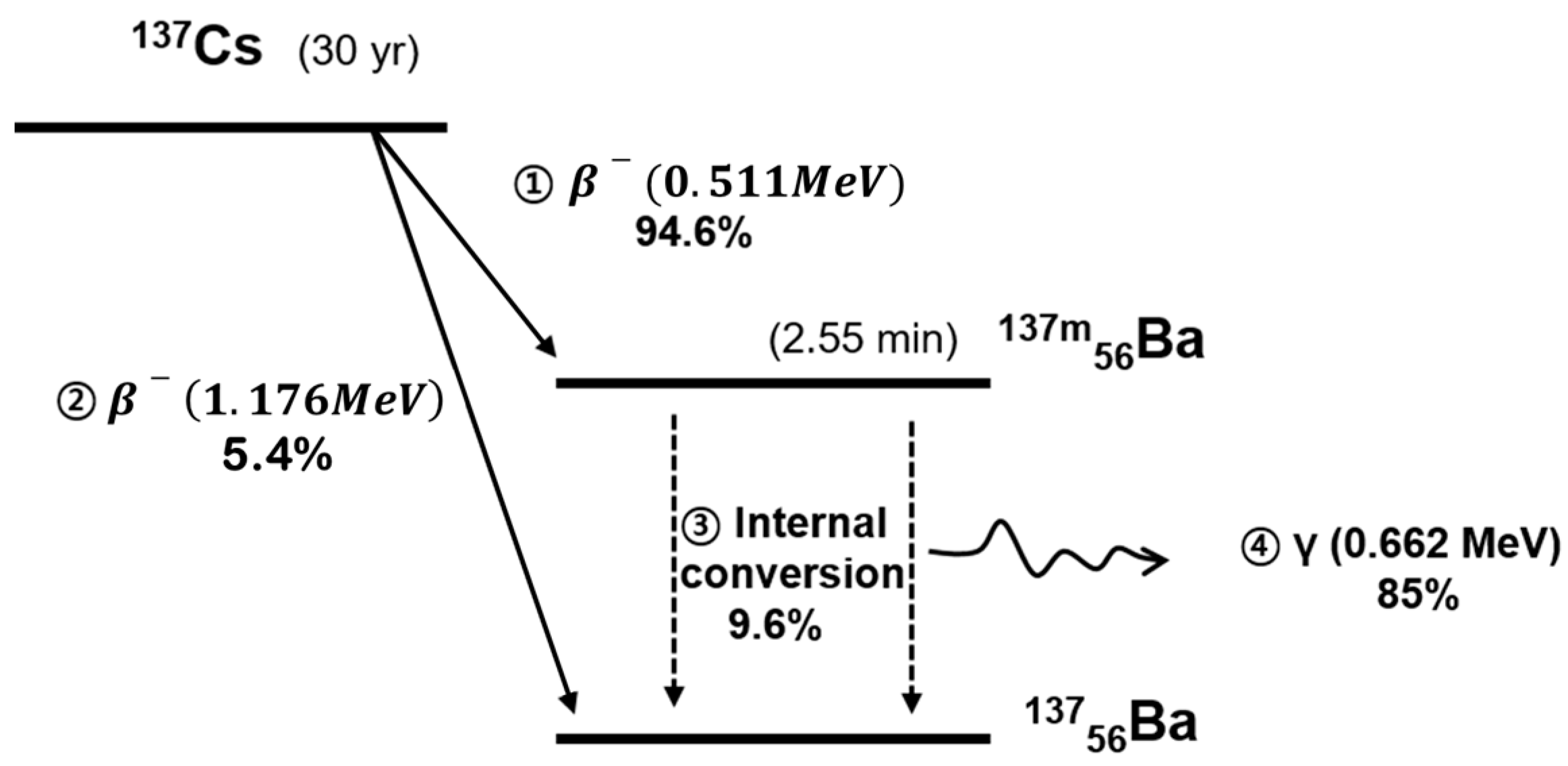

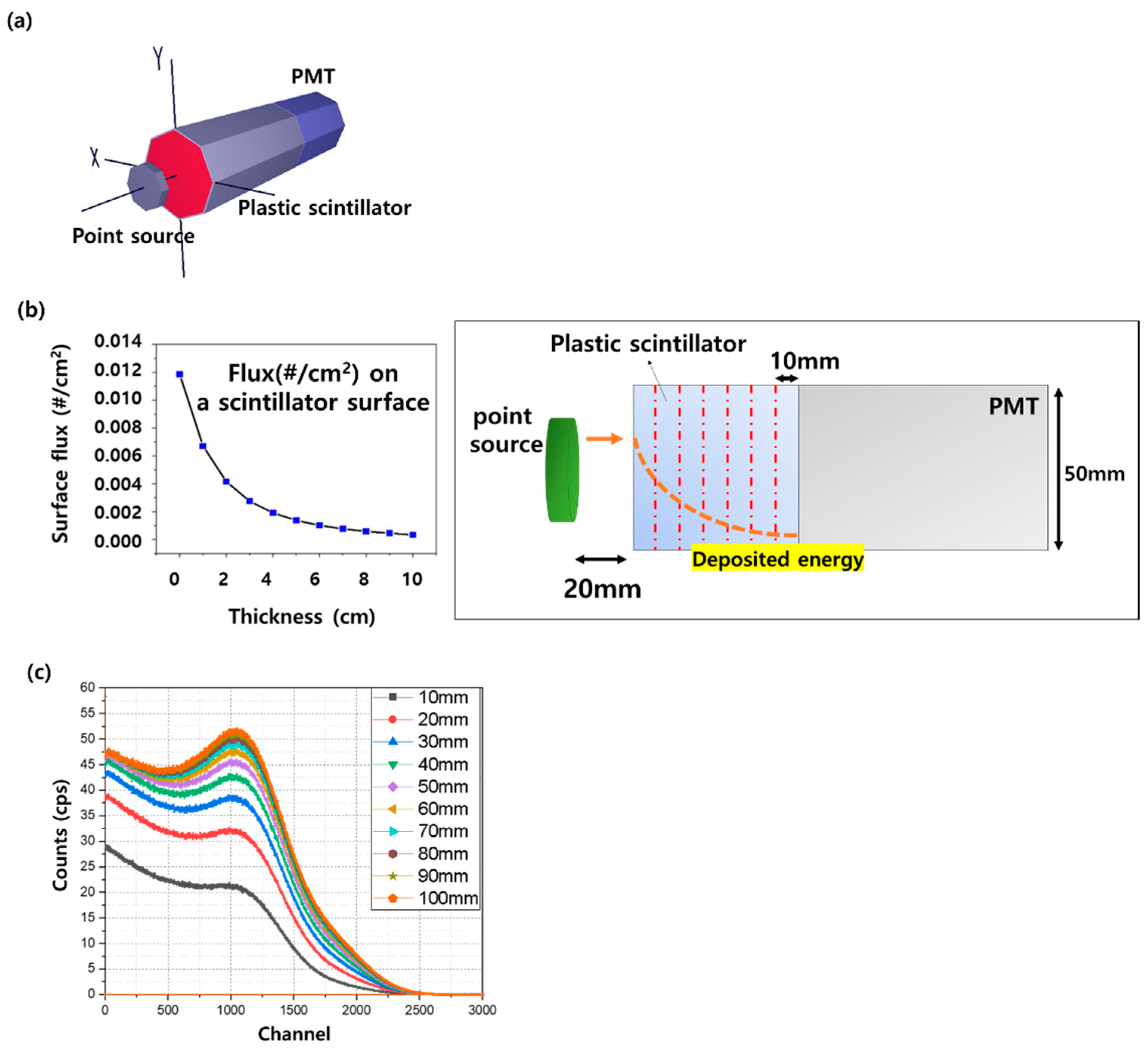
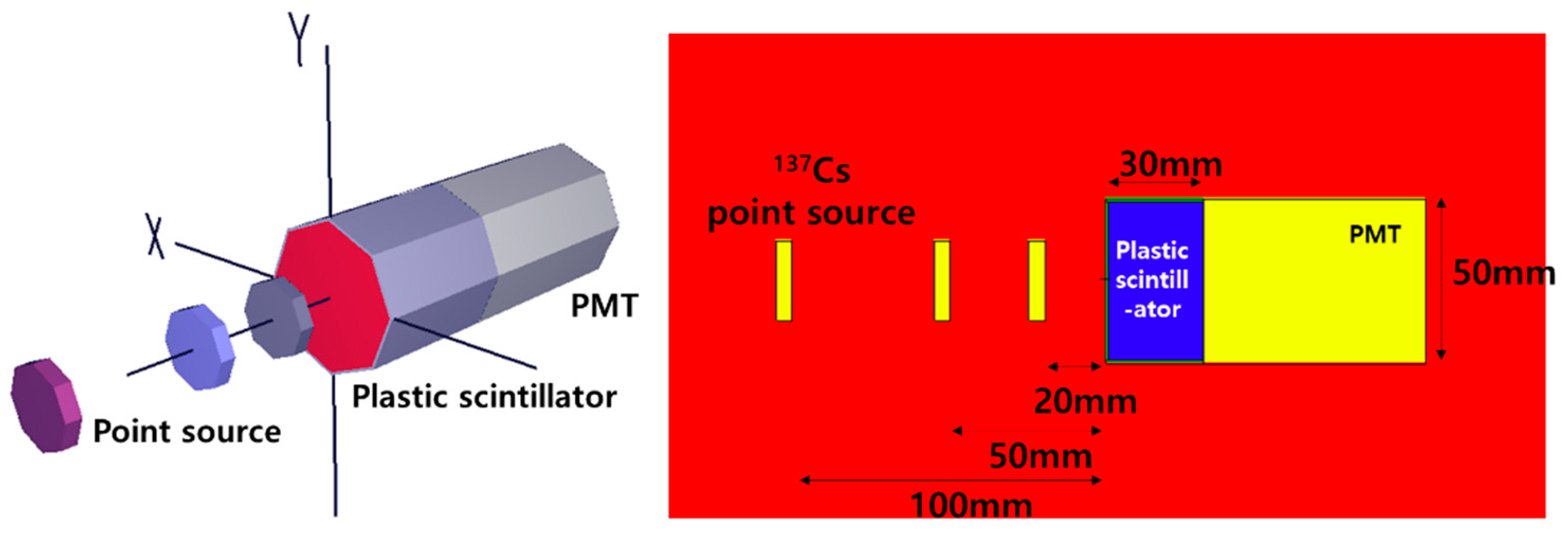

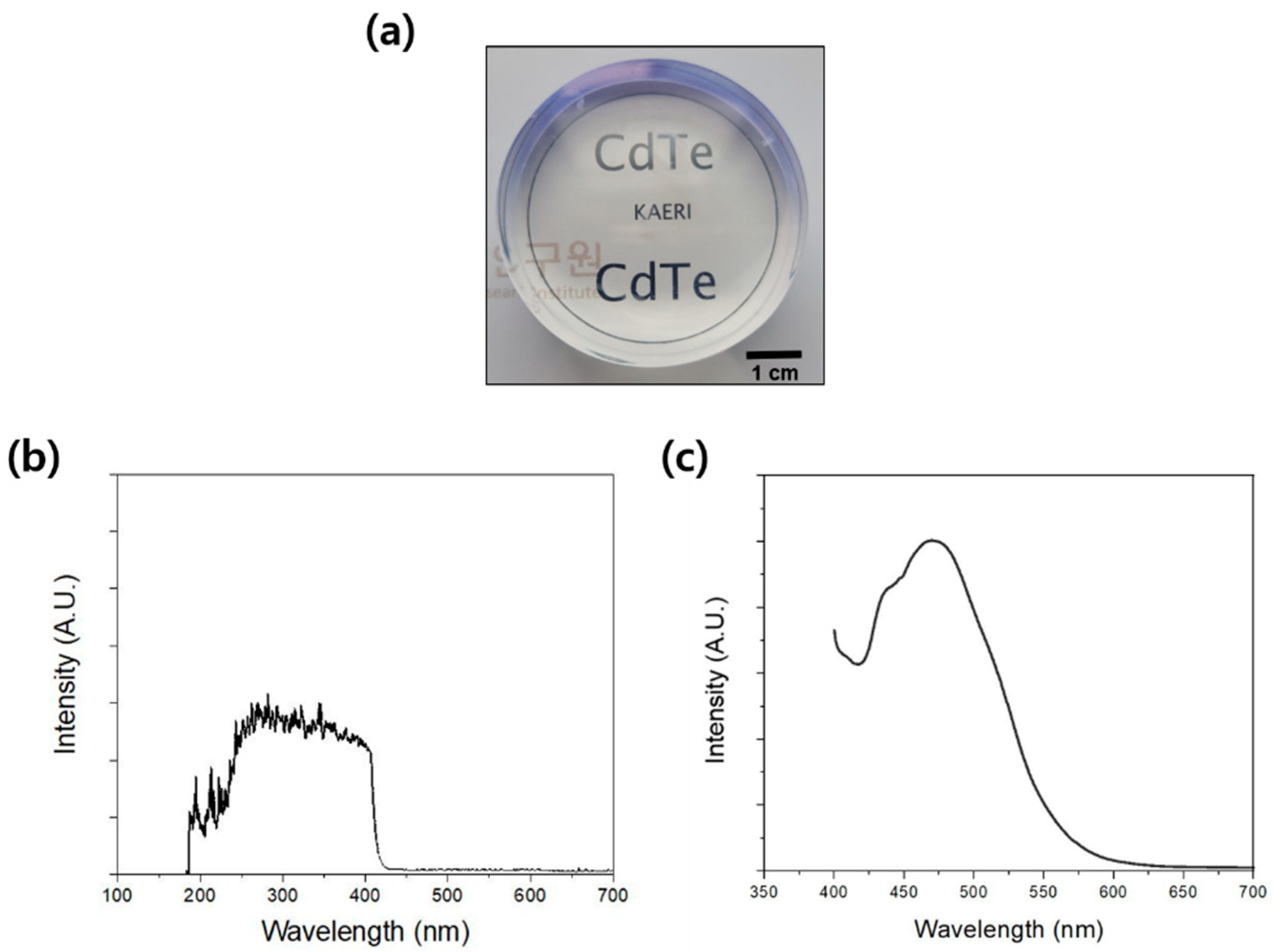

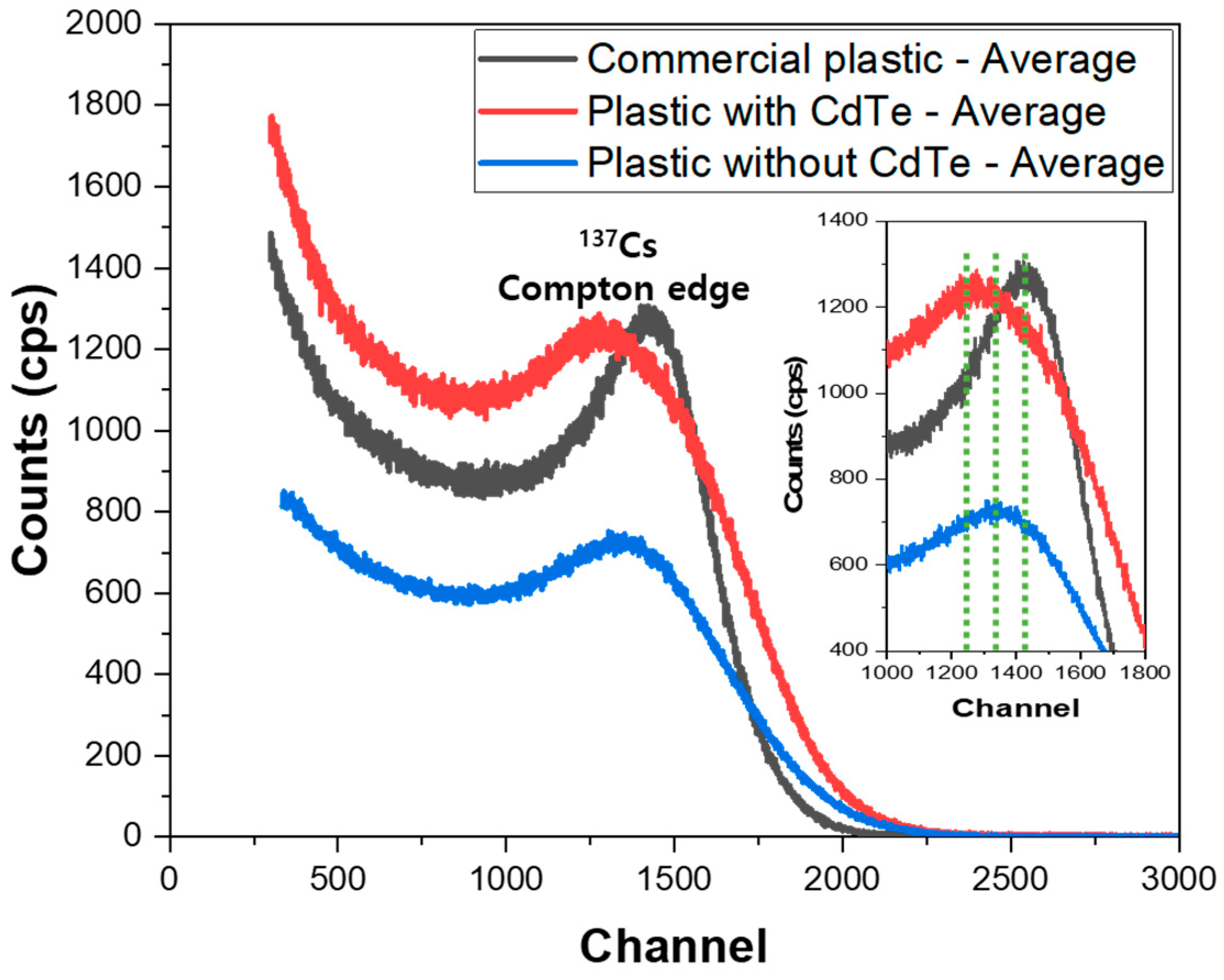
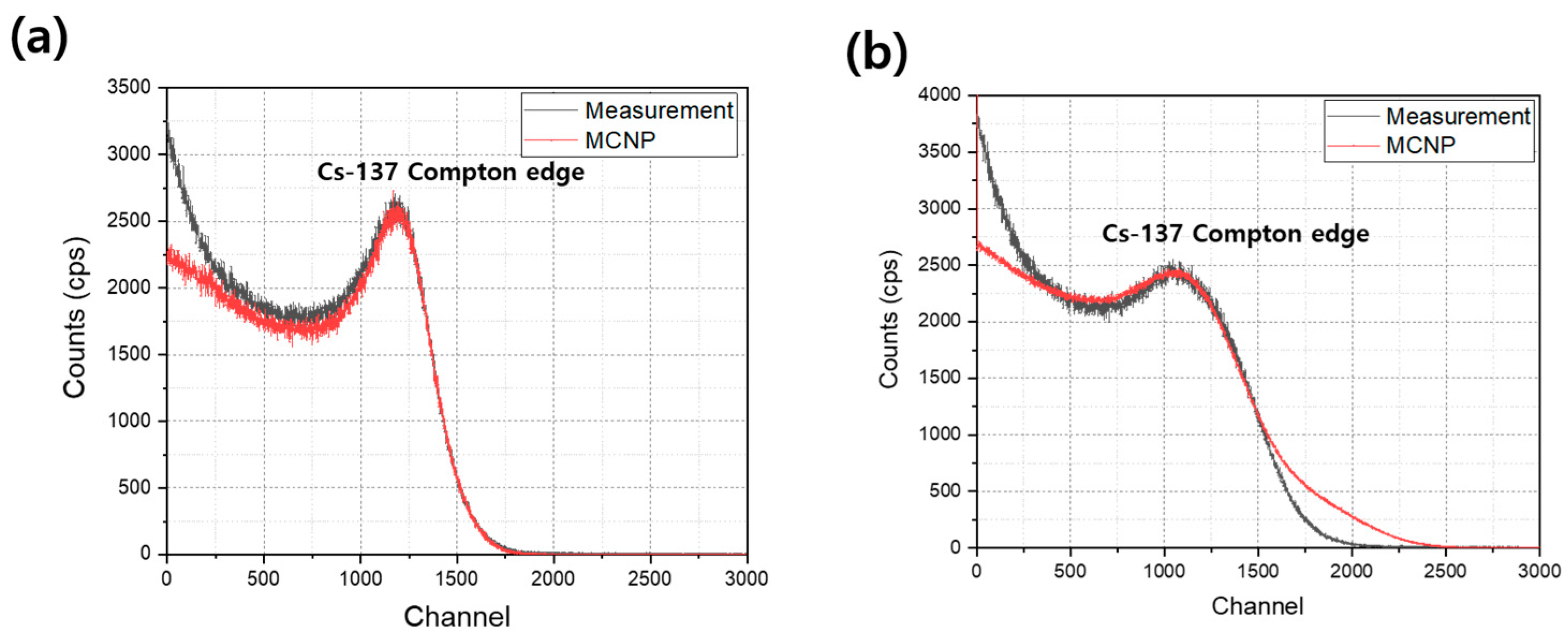

| 137Cs | (Ek)max | (Ek)avg | (Eγ) | Probability | |
|---|---|---|---|---|---|
| ① | β− decay | 0.514 MeV | 0.170 MeV | - | 94.6% |
| ② | β− decay | 1.176 MeV | 0.420 MeV | - | 5.4% |
| ③ | Internal conversion (K shell) | - | - | - | 7.8% |
| Internal conversion (L, M shell) | - | - | - | 1.80% | |
| ④ | γ decay | - | - | 0.662 MeV | 85% |
| Net Count (cps) | Relative Efficiency (%) | Detection Efficiency (%) | ||
|---|---|---|---|---|
| Commercial plastic | 20 mm | 3,644,431 ± 495,634 | 100.00 | 2.09 |
| 50 mm | 1,332,009 ± 99,208 | 100.00 | 0.76 | |
| 100 mm | 474,203 ± 23,352 | 100.00 | 0.27 | |
| Plastic without CdTe | 20 mm | 1,803,557 ± 2657 | 49.49 | 1.03 |
| 50 mm | 781,528 ± 582 | 58.67 | 0.45 | |
| 100 mm | 303,323 ± 53 | 63.96 | 0.17 | |
| Plastic with CdTe | 20 mm | 4,100,748 ± 558,312 | 112.52 | 2.35 |
| 50 mm | 1,608,902 ± 120,952 | 120.79 | 0.92 | |
| 100 mm | 593,654 ± 331 | 125.19 | 0.34 | |
| Terms | 20 mm | 50 mm | 100 mm |
|---|---|---|---|
| CECd | 1295 ch | 1298 ch | 1291 ch |
| CEEJ | 1430 ch | 1444 ch | 1434 ch |
| QECd | 0.15% | ||
| QEEJ | 0.2% | ||
| LYEJ | 10,000 photon/MeV | ||
| Relative LYCd | 12,075 photon/MeV | 12,103 photon/MeV | 12,037 photon/MeV |
| Nanomaterials | Methods | Results | Year | Ref. |
|---|---|---|---|---|
| CdTe/BaFBr:Eu2+ nanocomposite phosphors | - CdTe QD is weak in X-ray emission, so a CdTe/BaFBr:Eu2+ nanocomposite was prepared to evaluate its property. - Analyze the size and structure of nanoparticles by TEM. | - Strength increases as energy is transferred from Eu2+ to CdTe QD. - As it can be emitted in the near infrared range (650–1100 nm), which is a tissue optical window for in vivo imaging, the possibility of using it as a semiconductor/phosphor nanocomposite material is evaluated. | 2006 | [43] |
| CdTe quantum dots and polymer nanocomposites | - After synthesis by adding CdTe QD having various emission ranges to PMMA-based materials, the applicability to the X-ray imaging field was evaluated. - A nanocomposite film containing 0.1–10 wt% of CdTe QD was prepared and the characteristics were evaluated. - Use of bulk polymerization method to secure transparency | Excellent X-ray emission results including high resolution, fast decay time, afterglow prevention, high stopping power, and excellent spectral matching to the CCD detector | 2011 | [44] |
| LaF3:Cd/CdTe nanocomposites | - LaF3:Ce/CdTe nanocomposite was prepared to observe the X-ray emission characteristics of CdTe QD - Analyze the size and structure of nanoparticles through TEM | - The X-ray emission of CdTe QD is very weak, but the emission of LaF3:Ce/CdTe increases (six times) - CdTe QD shows the characteristics of intense photoluminescence and up-conversion light emission, and short decay time characteristics | 2012 | [45] |
| CdTe Photovoltaic Devices | - In order to improve the performance of the CdTe-based solar cell, the developed CdCl2 heat treatment was applied to the CdTe of the upper layer structure in which most of the reactions occur. - Improved efficiency by controlling the junction of CdTe-based solar cells | - CdTe is widely used due to the simplicity of the structure and the efficiency compared to the doped amount, and the efficiency of the CdTe-based solar cell is improved through the CdCl2 heat treatment method. - By improving the characteristics of the interface layer (IFL), it shows an efficiency of 10.97%. | 2012 | [46] |
| CdTe quantum dots synthesized using 3-mercaptopropionic acid reduction of tellurium dioxide | - A facile one-step synthesis of CdTe quantum dots (QDs) in aqueous solution by atmospheric microwave reactor has been developed using 3-mercaptopropionic acid reduction of TeO2 directly. - The obtained CdTe QDs were characterized by ultraviolet–visible spectroscopy, fluorescent spectroscopy, X-ray powder diffraction, multifunctional imaging electron spectrometer (XPS), and high-resolution transmission electron microscopy | - Green to red-emitting CdTe QDs with a maximum photoluminescence quantum yield of 56.68% were obtained. - The as-synthesized CdTe QDs were highly luminescent, which ensures their promising future applications as biological labels | 2013 | [47] |
| Plastic scintillator containing Gd2O3 or CdTe | - A plastic detector is manufactured by adding a fluorescent material and a nano material (Gd2O3 or CdTe) to an epoxy-based material. - Evaluating the efficiency using a beta source (Sr-90) | - As a result of characterization evaluation after adding the concentration of QD by 0.05–1 wt%, 0.1 wt% was analyzed as the most optimized concentration. | 2019 | [36] |
| Silver ion-doped CdTe quantum dots | - This is a study to use CdTe QD as a fluorescent probe for Hg2+ detection - To expand the detection concentration range of Hg2+, Ag ions were doped with CdTe QD - The characteristics of the produced QD were analyzed. | - As a result of investigating the release mechanism of Ag-doped CdTe QD, it shows multiple release in QD samples with high Ag+ doping concentration - The highest PL quantum yield of the QD sample was analyzed as 59.4% | 2020 | [48] |
| Thioglycolic acid-capped CdTe quantum dots | - Develop CdTe QD synthesis method to improve quantum yield - Evaluating the characteristics of specific substances (SAL) by concentration through fluorescence quenching mechanism - Using the ratio of ([Cd2+]:[HTe-]:[TGA(Thioglycolic acid)] = 1:0.5:2.4), CdTe QD with high photoluminescence was synthesized at 140 °C. | - Synthesizing CdTe with an emission wavelength of 540–560 nm and evaluating the possibility of using it for SAL detection - Evaluating the concentration of additives (SAL) using the degree of extinction of QD | 2021 | [49] |
| Non-polar PMMA solvent of CdTe quantum dots by silica coating | - Using CdTe coated with SiO2 (CdTe@SiO2) and PMMA, a nanocomposite material was produced that efficiently exhibits Stokes shift - The characteristics of CdTe coated with silica and without silica were compared and analyzed. | - In the PMMA/CdTe thin film without silica coating, non-uniform CdTe particles act as defects in the matrix. - In the PMMA/CdTe thin film coated with silica, clusters of uniform size were observed. - The emission spectrum of SiO2 overlaps with the excitation wavelength range of CdTe QD to increase the response of the optical system | 2021 | [50] |
| CdTe quantum dots using a binary solvent (water and glycerin) | - Comparison of optical and structural characteristics between CdTe QDs - Analyzing the optical properties of CdTe nanocrystals made with various synthesis parameters | - The optical properties of CdTe QD showed the highest emission quantum yield when synthesized with a binary solvent. - CdTe QD prepared with a Cd:Te molar ratio of 20:1 showed a narrow photoluminescence band and improved quantum yield | 2021 | [51] |
| CdTe quantum dots and graphene quantum dots | - A study on the spectral characteristics of a wide range of CdTe quantum dots and wide-gap graphene QD was conducted. - A technology to replace the organic shell of CdTe QD of various sizes was proposed. - Light stability when irradiated with radiation on CdTe QD and wide-gap graphene quantum dots was compared and analyzed. | - Colloidal graphene quantum dots and CdTe investigated in this work retain their optical and structural properties when exposed to radiation in the visible range - In the case of CdTe QD, the maximum intensity of the irradiated sample did not change within the measurement error, but in the case of graphene QD, the intensity decreased when irradiated with ultraviolet rays. | 2021 | [52] |
| CdTe/PPO/POPOP/Polystyrene | - Monolith-typed functional plastic scintillator having a diameter of 50 mm and a thickness of 30 mm was manufactured by adding 2,5-diphenyloxazole (PPO, 0.4 wt%), 1,4 di[2-(5phenyloxazolyl)]benzene (POPOP, 0.01 wt%), and CdTe (0.2 wt%) materials in a styrene-based matrix. | - Integrated and portable probe based on a functional plastic scintillator for detection of Cs-137. - Remarkable performance of the functional plastic scintillator was confirmed through comparative analysis with Monte Carlo simulation. | 2021 | This work |
Publisher’s Note: MDPI stays neutral with regard to jurisdictional claims in published maps and institutional affiliations. |
© 2021 by the authors. Licensee MDPI, Basel, Switzerland. This article is an open access article distributed under the terms and conditions of the Creative Commons Attribution (CC BY) license (https://creativecommons.org/licenses/by/4.0/).
Share and Cite
Min, S.; Kang, H.; Seo, B.; Roh, C.; Hong, S.; Cheong, J. Integrated and Portable Probe Based on Functional Plastic Scintillator for Detection of Radioactive Cesium. Appl. Sci. 2021, 11, 5210. https://doi.org/10.3390/app11115210
Min S, Kang H, Seo B, Roh C, Hong S, Cheong J. Integrated and Portable Probe Based on Functional Plastic Scintillator for Detection of Radioactive Cesium. Applied Sciences. 2021; 11(11):5210. https://doi.org/10.3390/app11115210
Chicago/Turabian StyleMin, Sujung, Hara Kang, Bumkyung Seo, Changhyun Roh, Sangbum Hong, and Jaehak Cheong. 2021. "Integrated and Portable Probe Based on Functional Plastic Scintillator for Detection of Radioactive Cesium" Applied Sciences 11, no. 11: 5210. https://doi.org/10.3390/app11115210
APA StyleMin, S., Kang, H., Seo, B., Roh, C., Hong, S., & Cheong, J. (2021). Integrated and Portable Probe Based on Functional Plastic Scintillator for Detection of Radioactive Cesium. Applied Sciences, 11(11), 5210. https://doi.org/10.3390/app11115210







